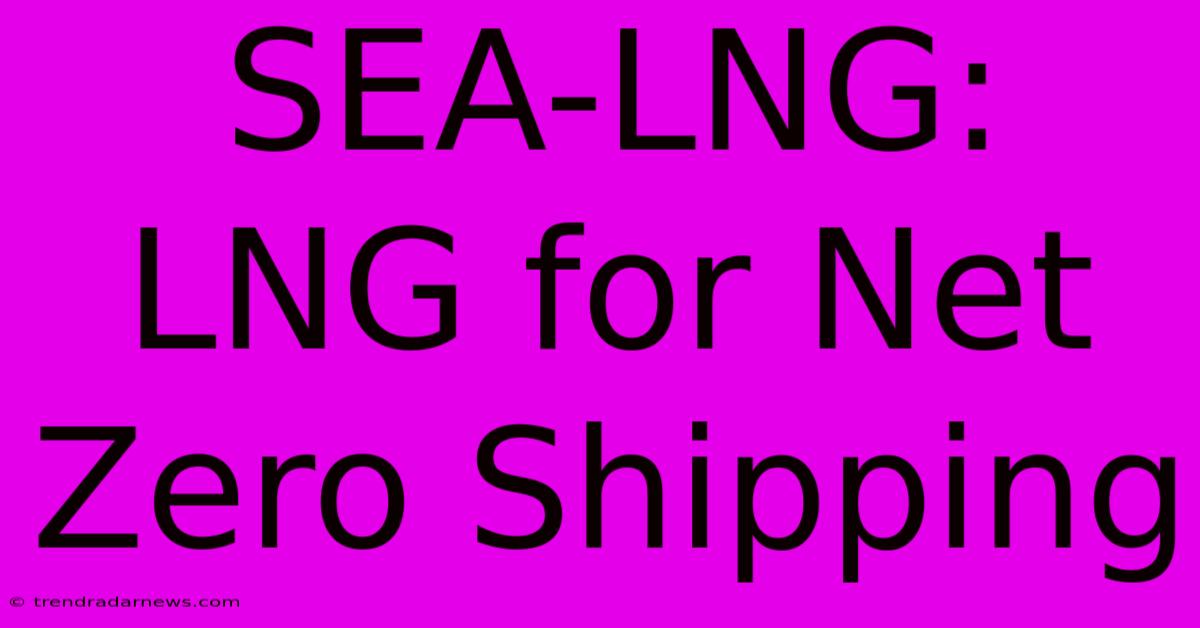SEA-LNG: LNG For Net Zero Shipping

Discover more detailed and exciting information on our website. Click the link below to start your adventure: Visit Best Website SEA-LNG: LNG For Net Zero Shipping. Don't miss out!
Table of Contents
SEA-LNG: Charting a Course Towards Net-Zero Shipping with LNG
Hey y'all! So, I've been digging into this whole "green shipping" thing lately, and let me tell you, it's a wild ride. One of the biggest players I've come across is SEA-LNG – the Shipping for Energy and Environmental Action – LNG Partnership. They're all about using Liquefied Natural Gas (LNG) as a stepping stone towards net-zero emissions in the shipping industry. And trust me, that's a HUGE deal.
I'll admit, when I first heard about LNG as a solution, I was kinda skeptical. I mean, it's still a fossil fuel, right? But SEA-LNG's argument is a bit more nuanced than that. They see LNG as a transitional fuel – a much cleaner option than traditional heavy fuel oil (HFO), buying us crucial time to develop and implement truly zero-emission technologies.
Why LNG? The SEA-LNG Argument
SEA-LNG makes a strong case for LNG's role in decarbonizing shipping. They highlight some pretty compelling facts:
-
Significantly Reduced Emissions: Compared to HFO, LNG drastically cuts emissions of sulfur oxides (SOx), particulate matter (PM), and nitrogen oxides (NOx). These are serious air pollutants that wreak havoc on human health and the environment. Think cleaner air in port cities – a huge win!
-
Methane Slippage: The Elephant in the Room Okay, so here's where it gets tricky. LNG does release methane, a potent greenhouse gas, during its lifecycle. This "methane slippage" is a big concern, and SEA-LNG acknowledges it. They're pushing for technological advancements to minimize these emissions. The good news is, significant progress is being made on reducing methane leakage from LNG fuel systems.
-
A Stepping Stone, Not the Finish Line: SEA-LNG isn't presenting LNG as the ultimate solution. They see it as a bridge to a future powered by zero-emission fuels like hydrogen and ammonia. It's about reducing emissions now while we work towards more sustainable alternatives.
My Initial Skepticism and My Change of Heart
Initially, I was super skeptical. I thought, "Isn't this just greenwashing?" After all, any emissions are bad emissions, right? I spent hours researching, reading reports, and honestly, feeling pretty overwhelmed. There's so much conflicting information out there!
But then I started seeing the bigger picture. The shipping industry's emissions are HUGE. We're talking about a massive sector that needs to drastically reduce its carbon footprint. Transitioning to LNG isn't perfect, but it's a heck of a lot better than sticking with HFO. It's about progress, not perfection. And let's be real, even small steps matter!
Practical Tips for Staying Informed
So, what have I learned from all this? Well, for starters, staying informed is key. Don't just rely on one source – read up on different perspectives, especially reports from reputable organizations like the IMO (International Maritime Organization).
Here are a few things I found helpful:
- Dive into the SEA-LNG website: It's packed with information, reports, and case studies.
- Follow industry news: Stay updated on the latest advancements in LNG technology and regulations.
- Think critically: Don't take everything at face value. Assess the sources and look for evidence-based arguments.
The bottom line is, the transition to net-zero shipping is a complex challenge, and LNG, while imperfect, plays a significant role in the near-term. SEA-LNG's work is highlighting a pathway forward, and even though there are challenges, the progress being made offers a glimmer of hope for a cleaner, more sustainable future for the shipping industry. Now, if you'll excuse me, I'm off to read another report... this stuff is seriously fascinating (and sometimes frustrating!).

Thank you for visiting our website wich cover about SEA-LNG: LNG For Net Zero Shipping. We hope the information provided has been useful to you. Feel free to contact us if you have any questions or need further assistance. See you next time and dont miss to bookmark.
Featured Posts
-
Overtime Win For Jets Against Avalanche
Jan 24, 2025
-
Remember Night Agent Season 1
Jan 24, 2025
-
Europa League Az Vs Roma Starting Xi
Jan 24, 2025
-
American Keys In Australian Open Final
Jan 24, 2025
-
Dramatic Rangers Equalizer
Jan 24, 2025
